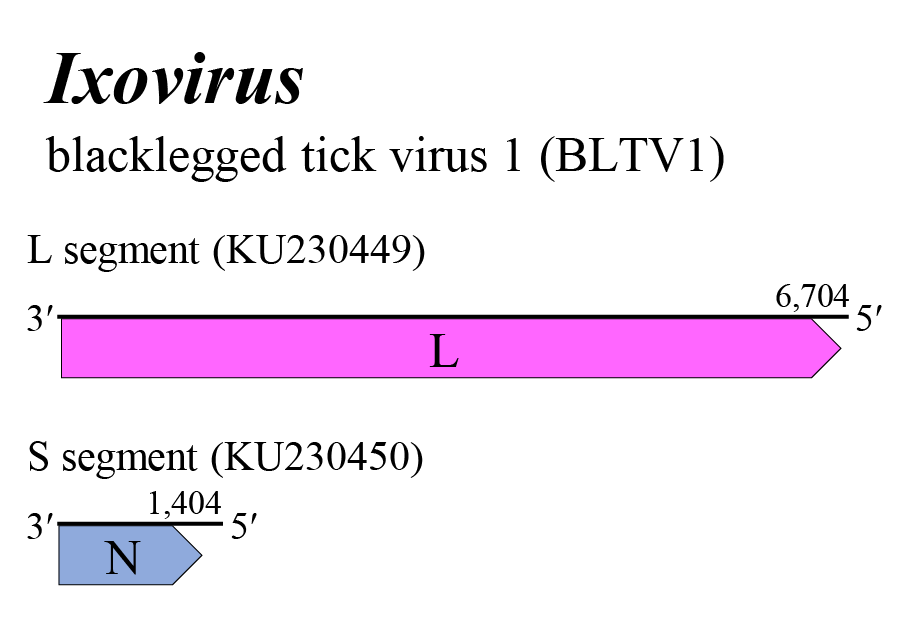Family: Phenuiviridae
Genus: Ixovirus
Distinguishing features
Ixoviruses were first discovered in black-legged ticks in USA. Three viruses, blacklegged tick virus 1 (BLTV1), blacklegged tick virus 3 (BLTV3) and Fairhair virus (FHAV) are assigned to the genus Ixovirus. Unlike other phenuivirids, the genome of ixoviruses comprises only two segments of negative-sense RNA and has only two genes, encoding a large protein (L) and a nucleocapsid protein (N). Based on well-supported Maximum Likelihood or Maximum Clade Credibility trees inferred from complete L protein sequences, viruses classified in the genus Ixovirus form a monophyletic cluster clearly distinguished from other phenuivirids (Tokarz et al., 2014, Pettersson et al., 2017, Tokarz et al., 2018).
Virion
Morphology
Virion morphology is unknown. Based on the putative proteins encoded by the virus genome, the virion is probably a filamentous virion without an envelope.
Nucleic acid Protein
The ixovirus genome encompass two segments of negative-sense RNA. The terminal nucleotides of each segment occur in a canonical, conserved sequence (in coding sense) 5′-ACACAAAGGC…GCCAUUGUGU-3′ and may form the panhandle structures typical of other members of the class Bunyaviricetes (Table 2 Phenuiviridae). The genomic RNAs contain non-coding regions flanking a single ORF which, based on comparisons with other negative-sense RNA viruses, is predicted to be contained in the virus-complementary strand. The L segment (6.7 kb) encodes a protein with a predicted molecular mass of 250–253 kDa that is homologous with the bunyaviral RNA-directed RNA polymerase (RdRP) domain. The S segment (1.4–2.5 kb) encodes a protein of 44–58 kDa that is homologous with the tenuivirus/phlebovirus N domain (Table 3 Phenuiviridae) (Tokarz et al., 2014, Pettersson et al., 2017, Tokarz et al., 2018).
Genome organization and replication
Unlike other phenuivirids, ixoviruses have only two genes, encoding L and N (Figure 1 Ixovirus). The glycoprotein that is thought to be related to vector transmission, is not confirmed in ixoviruses. Details of virus replication are unknown (Tokarz et al., 2014, Pettersson et al., 2017, Tokarz et al., 2018).
 |
| Figure 1.Ixovirus. Genome organization of an ixovirus. Coloured boxes depict ORFs that encode N, nucleocapsid protein and L, large protein. |
Biology
Ixovirus RNA was found in black-legged ticks [Ixodes scapularis (Say, 1821)] and castor bean ticks [I. ricinus (Linnaeus, 1758)] in USA and Norway. Vertebrate hosts have not been identified (Tokarz et al., 2014, Pettersson et al., 2017, Tokarz et al., 2018).
Species demarcation criteria
The criteria demarcating species in the genus are:
• Less than 95% identity in the amino acid sequence of the RdRP.

